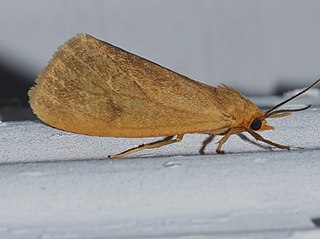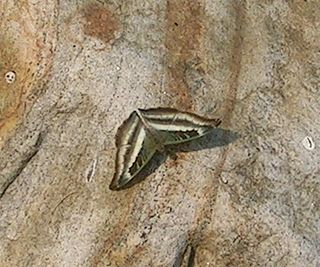
Pontia daplidice, the Bath white, is a small butterfly of the family Pieridae, the yellows and whites, which occurs in the Palearctic region. It is common in central and southern Europe, migrating northwards every summer, often reaching southern Scandinavia and sometimes southern England.

Papilio clytia, the common mime, is a swallowtail butterfly found in south and southeast Asia. The butterfly belongs to the subgenus Chilasa, the black-bodied swallowtails. It serves as an excellent example of a Batesian mimic among the Indian butterflies.

Discolampa ethion, the banded blue Pierrot, is a contrastingly marked butterfly found in South Asia that belongs to the blues or family Lycaenidae. The species was first described by John O. Westwood in 1851.

Miletus boisduvali, the common brownie, is a small but striking butterfly found in India and Myanmar that belongs to the lycaenids or blues family.

Lycaenopsis transpectus, the white-banded hedge blue, is a small butterfly found in India that belongs to the Lycaenids or Blues family.

Prosotas nora, the common lineblue, is a species of lycaenid butterfly found in Asia to Australia. The species was first described by Rudolf Felder in 1860.
Plebejus christophi, the small jewel blue, is a small butterfly found in Asia that belongs to the lycaenids or blues family.

Vindula erota, the common cruiser, is a species of nymphalid butterfly found in forested areas of tropical South Asia and Southeast Asia.

Virbia aurantiaca, the orange holomelina, is a moth species of the family Erebidae found in North America. In the east it has been recorded from Manitoba and Nova Scotia, south along the eastern seaboard to Cordoba in Mexico. It has also been recorded from Texas, Mississippi, Missouri, Tennessee, Louisiana, Oklahoma, Kansas, North Dakota and South Dakota.
Virbia fergusoni is a moth in the family Erebidae. It was described by Jennifer M. Zaspel in 2008. It is found in the south-eastern United States, ranging to South Carolina in the north and from Georgia and northern Florida to Alabama in the west. The habitat consists of mixed oak-pine forests.
Virbia ferruginosa, the rusty holomelina, is a moth in the family Erebidae. It was described by Francis Walker in 1854. It is found from Nova Scotia to British Columbia in Canada. In the United States it is found from the northeast and upper Midwest, south to Virginia, Mississippi, Missouri and Louisiana.
Virbia fragilis is a moth in the family Erebidae. It was described by Strecker in 1878. It is found in open fields in the Black Hills in South Dakota and in Boulder, Colorado. The range extends north to Alberta and British Columbia and south to New Mexico.
Virbia immaculata, the immaculate holomelina or plain-winged holomelina, is a moth in the family Erebidae. It was described by Tryon Reakirt in 1864. It is found from the eastern coast of North America west to Manitoba. It has also been recorded in Iowa, Illinois and Indiana.
Virbia lamae, the bog holomelina, is a moth in the family Erebidae. It was described by Thomas Nesbitt Freeman in 1941. It is found in North America in Nova Scotia, New Brunswick, Maine, Wisconsin and Michigan. The habitat consists of open peat bogs.
Virbia marginata is a moth in the family Erebidae. It was described by Herbert Druce in 1885. It is found in Mexico, Guatemala, Honduras, New Mexico and Arizona.
Virbia nigricans is a moth in the family Erebidae. It was described by Tryon Reakirt in 1864. It is found in the United States in secondary secession habitats of western New Jersey and Pennsylvania.

Virbia opella, the tawny holomelina, is a moth in the family Erebidae. It was described by Augustus Radcliffe Grote in 1863. It is found in the United States from Maine west to Illinois and south to Texas. The habitat consists of oak forests and scrub oak forests.

Virbia ostenta, the showy holomelina, is a moth in the family Erebidae. It was described by Henry Edwards in 1881. It is found in the mountain ranges of New Mexico, Arizona and Mexico.

Virbia rubicundaria, the ruddy holomelina, black-banded holomelina or least holomelina, is a moth in the family Erebidae. It is found from Georgia and Florida, along the Gulf Coast to eastern Texas.

Auzakia is a monotypic butterfly genus in the family Nymphalidae. It contains the single species, Auzakia danava, the commodore, which is found from Tibet to Sumatra.











